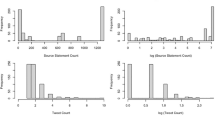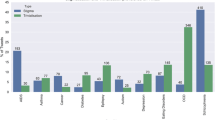Abstract
Losing the gift of vision has been affecting people’s lives on many fronts. People with visual impairments are susceptible to social isolation due to the lack of public awareness about their needs and abilities. Such lack of awareness also impacts the opportunities available to the visually impaired to be productive members of their society. Global, national, and civil organizations have conducted several annual campaigns to educate the public about the abilities and potential of the visually impaired, raise awareness about the preventable causes of visual impairments, and engage the public in the contemporary efforts to fight preventable blindness. In particular, Twitter is one of the most effective information dissemination platforms in our age, and it has been actively used in such awareness campaigns. In this paper, we aim to analyze the use of Twitter in the impairment awareness campaigns. We organize our analysis in terms of five key concerns: (1) the characteristics of active users during the event, (2) the major players in information dissemination, (3) the tweets’ common topics (4) the reachability of the information, and (5) the temporal tweeting behavior. We report the results of our analysis along with the design of an effective communication strategy of a campaign.





Similar content being viewed by others
Notes
Also known as the Blind Americans Equality Day.
References
AFB (2017) Learning about blindness. http://www.afb.org/info/living-with-vision-loss/for-job-seekers/for-employers/visual-impairment-and-your-current-workforce/learning-about-blindness/12345
Al Zayer M, Gunes MH (2017) Analyzing the use of twitter to disseminate visual impairments awareness information. In: Proceedings of the 2017 IEEE/ACM International Conference on Advances in Social Networks Analysis and Mining. ASONAM ’17, ACM, New York, pp 187–194. https://doi.org/10.1145/3110025.3110137
Barabási A, Bonabeau E (2003) Scale-free networks. Sci Am 288(5):60–69
Blei DM, Ng AY, Jordan MI (2003) Latent dirichlet allocation. J Mach Learn Res 3(Jan):993–1022
Blondel VD, Guillaume JL, Lambiotte R, Lefebvre E (2008) Fast unfolding of communities in large networks. J Stat Mech Theory Exp 2008(10):P10,008
Borondo J, Morales A, Losada JC, Benito RM (2012) Characterizing and modeling an electoral campaign in the context of twitter: 2011 spanish presidential election as a case study. Chaos 22(2):023138
Bravo CA, Hoffman-Goetz L (2015) Tweeting about prostate and testicular cancers: what are individuals saying in their discussions about the 2013 movember canada campaign? J Cancer Educ:1–8
CBCNational (2017) White cane week. http://ccbnational.net/fresco/white-cane-week/
Chung JE (2016) A smoking cessation campaign on twitter: understanding the use of twitter and identifying major players in a health campaign. J Health Commun 21(5):517–526
Clauset A, Shalizi CR, Newman ME (2009) Power-law distributions in empirical data. SIAM Rev 51(4):661–703
Dyar OJ, Castro-Sánchez E, Holmes AH (2014) What makes people talk about antibiotics on social media? a retrospective analysis of twitter use. J Antimicrob Chemother 69(9):2568–2572
Freeman LC (1977) A set of measures of centrality based on betweenness. Sociometry, pp 35–41
Fussell Sisco H, McCorkindale T (2013) Communicating pink : an analysis of the communication strategies, transparency, and credibility of breast cancer social media sites. Int J Nonprofit Volunt Sector Mark 18(4):287–301
Gephi (2017) Gephi. https://gephi.org/
Harris JK (2013) Local health department use of twitter to disseminate diabetes information, united states. Preventing chronic disease 10
Howard PN, Duffy A, Freelon D, Hussain MM, Mari W, Maziad M (2011) Opening closed regimes: what was the role of social media during the arab spring? Available at SSRN 2595096
Hutter K, Hautz J, Dennhardt S, Füller J (2013) The impact of user interactions in social media on brand awareness and purchase intention: the case of mini on facebook. J Prod Brand Manag 22(5/6):342–351
IAPB (2017) World sight day. http://www.iapb.org/advocacy/world-sight-day
Kempe D, Kleinberg J, Tardos É (2003) Maximizing the spread of influence through a social network. In: Proceedings of the ninth ACM SIGKDD international conference on Knowledge discovery and data mining. ACM, New York, pp 137–146
Kleinberg JM (1999) Hubs, authorities, and communities. ACM Comput surv (CSUR) 31(4es):5
Kruskal WH, Wallis WA (1952) Use of ranks in one-criterion variance analysis. J Am Stat Assoc 47(260):583–621
Lapointe L, Ramaprasad J, Vedel I (2014) Creating health awareness: a social media enabled collaboration. Health Technol 4(1):43–57
MALLET (2017) MAchine Learning for LanguagE Toolkit. http://mallet.cs.umass.edu/
McClellan C, Ali MM, Mutter R, Kroutil L, Landwehr J (2016) Using social media to monitor mental health discussions- evidence from twitter. J Am Med Inf Assoc:ocw133
Nah S, Saxton GD (2012) Modeling the adoption and use of social media by nonprofit organizations. New Media & Society, pp 1461444812452411
NationalDayCalendar (2017) Blindness awareness month. https://nationaldaycalendar.com/world-blindness-awareness-month-october/
Neiger BL, Thackeray R, Van Wagenen SA, Hanson CL, West JH, Barnes MD, Fagen MC (2012) Use of social media in health promotion purposes, key performance indicators, and evaluation metrics. Health Promot pract 13(2):159–164
NFB (2017a) The blind americans equality day. https://nfb.org/white-cane-safety-day
NFB (2017b) Meet the blind month. https://nfb.org/meet-blind-month
Nooralahzadeh F, Arunachalam V, Chiru CG (2013) 2012 presidential elections on twitter–an analysis of how the us and french election were reflected in tweets. In: 2013 19th International Conference on Control Systems and Computer Science. IEEE, pp 240–246
Pearson K (1900) X. on the criterion that a given system of deviations from the probable in the case of a correlated system of variables is such that it can be reasonably supposed to have arisen from random sampling. Lond Edinb Dublin Philos Mag J Sci 50(302):157–175
PopulationClock (2016) Population clock. http://www.census.gov/popclock/
QuietAffiliate (2009) Quiet affiliate marketing: Free first-name and last-name databases (csv and sql). http://www.quietaffiliate.com/free-first-name-and-last-name-databases-csv-and-sql/
Reavley NJ, Pilkington PD (2014) Use of twitter to monitor attitudes toward depression and schizophrenia: an exploratory study. PeerJ 2:e647
Scanfeld D, Scanfeld V, Larson EL (2010) Dissemination of health information through social networks: Twitter and antibiotics. Am J Infect Control 38(3):182–188
Starbird K, Maddock J, Orand M, Achterman P, Mason RM (2014) Rumors, false flags, and digital vigilantes: Misinformation on twitter after the 2013 boston marathon bombing. iConference 2014 Proceedings
Thackeray R, Burton SH, Giraud-Carrier C, Rollins S, Draper CR (2013) Using twitter for breast cancer prevention: an analysis of breast cancer awareness month. BMC Cancer 13(1):1
Tobias E (2011) Using twitter and other social media platforms to provide situational awareness during an incident. J Bus Cont Emerg Plan 5(3):208–223
TweetReach (2017) Tweetreach. https://tweetreach.com/
Twitter (2017) Twitter: About verified accounts. https://support.twitter.com/articles/119135
Vance K, Howe W, Dellavalle RP (2009) Social internet sites as a source of public health information. Dermatol Clin 27(2):133–136
Verma R, Khanna P, Prinja S, Rajput M, Arora V (2011) The national programme for control of blindness in india. Australas Med J 4(1):1
Vieweg S, Hughes AL, Starbird K, Palen L (2010) Microblogging during two natural hazards events: what twitter may contribute to situational awareness. In: Proceedings of the SIGCHI conference on human factors in computing systems. ACM, New York, pp 1079–1088
WHO (2017) WHO visual impairment and blindness fact sheet. http://www.who.int/mediacentre/factsheets/fs282/en/
Wilcox R (2005) Kolmogorov–smirnov test. Encyclopedia of biostatistics
Wilcoxon F, Wilcox RA (1964) Some rapid approximate statistical procedures. Lederle Laboratories
Acknowledgements
This material is based upon work supported in part by the National Science Foundation under grant number EPS-IIA-1301726.
Author information
Authors and Affiliations
Corresponding author
Rights and permissions
About this article
Cite this article
Zayer, M.A., Gunes, M.H. Exploring visual impairment awareness campaigns on Twitter. Soc. Netw. Anal. Min. 8, 40 (2018). https://doi.org/10.1007/s13278-018-0515-0
Received:
Revised:
Accepted:
Published:
DOI: https://doi.org/10.1007/s13278-018-0515-0




